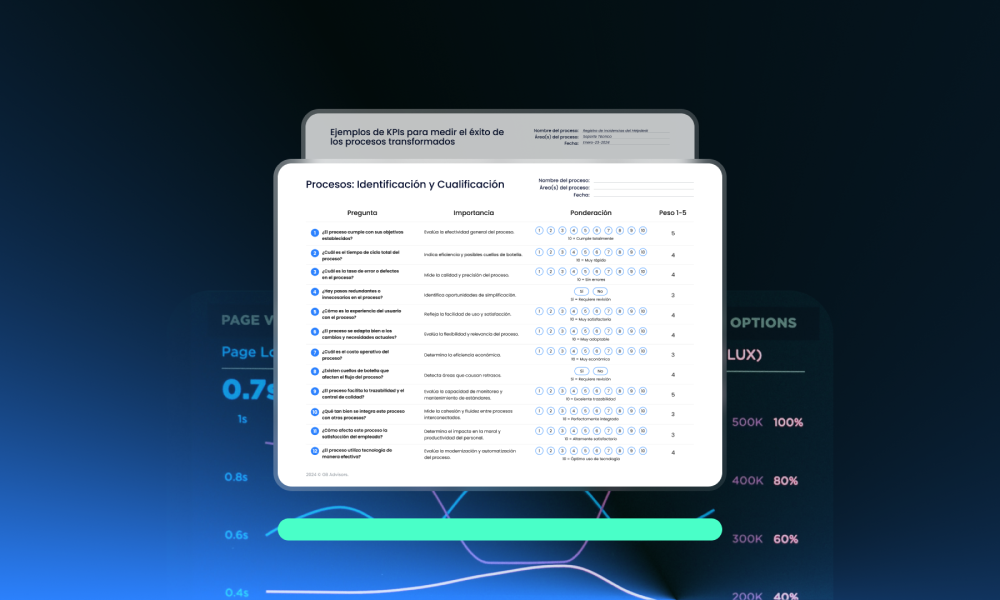In our latest video, “Digital Transformation: A Guide to Identifying and Evaluating Processes to Digitize”, we broke down this complex task into a clear and manageable process. Here, we take you through the highlights of the video, showing you how to identify opportunities to digitize processes and optimize your operations.
If you want the full content, feel free to watch the video!
1. Identification of key processes for digitization
Digitizing processes starts with identifying the right processes. But how do you identify them? Our video delves into techniques such as auditing current processes and data analysis to uncover these hidden processes, which can be starting points for your digital transformation. Here are some highlights:
- Start with a thorough review of existing processes.
- Involve your team and get their feedback.
- Use historical data and performance reports to identify areas for improvement.
- Benchmark your processes against industry best practices.
- Identify automation opportunities
- Analyze the feasibility of the process for digitization.
- Evaluate the impact of the identified process on the overall operation and the feasibility of digitization.
- Analyzes in detail the current workflow of the selected processes.
- Look for bottlenecks, redundancies, or inefficiencies in the current processes.
- Identifying and eliminating redundant steps or bottlenecks will simplify the process, save time and resources, and improve efficiency.
- Talk to all stakeholders, including senior management, the IT team, and end users.
- Consider the potential risks associated with digitizing each process. This includes technical, compliance, and operational risks.
- Clearly defines the technical requirements necessary for digitization. This includes software, hardware, integrations with other systems, and any other technological needs.
The proper use of technology in processes is critical. If a process is not taking advantage of modern technology, it could be operating below its potential.
2. Process Analysis for Digitization
Here, we assess the feasibility and potential impact of digitizing processes. We will analyze how to evaluate your costs, benefits, risks, and everything you need to make informed decisions.
- For each process identified, assess its impact on the overall operation and the feasibility of its digitization. Consider factors such as cost, time required for implementation, and available resources.
- Analyze in detail the current workflow of the selected processes. Understanding each step, who is involved, and how it is currently carried out is essential to designing an effective digital solution.
- Look for bottlenecks, redundancies, or inefficiencies in current processes.
- Talk to all stakeholders, including senior management, the IT team, and end users. Their perspective can offer valuable insights on how the process can be improved and what functionalities are critical in the digital solution.
- Consider the potential risks associated with digitizing each process. This includes technical, compliance, and operational risks.
- Clearly define the technical requirements needed for digitization. This includes software, hardware, integrations with other systems, and any other technological needs.
3. Decision-Making in the Digitalization of Processes
Strategic decision-making is the last crucial step in digitizing processes. This is where we weigh the data collected and formulate a plan of action. From selecting the right technology to change management, we cover all aspects necessary to ensure that your decisions lead to successful results.
- Based on your analysis, classify processes according to their importance, impact, and feasibility of digitization.
- Create a detailed plan for digitization implementation.
- Define key indicators to measure the success of digitization and make adjustments as needed.
- Decide on the technology and tools to be used for digitization. This may include selecting new ITSM software, automation tools, or customizing your current system.
- Develop a change management plan that includes internal communication, employee training, and strategies to overcome resistance to change.
- Before fully implementing digitized processes, conduct extensive testing to ensure that they are working properly.
- Once the digitized processes are implemented, regularly evaluate their performance and look for opportunities for improvement.
Apply this to your business with a free guide
Digitizing processes not only improves operational efficiency but also prepares your organization for the future. If you’re wondering how to apply these concepts in your company, we have a special resource for you. We’ve created a practical, comprehensive, and free guide called “Process Digitization Assessment and Success”. This guide delves into the topics discussed and offers practical tools for your process assessment.
Find the link in the description of our video, and don’t forget to subscribe to our channel for more valuable content!



